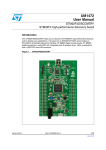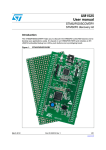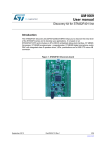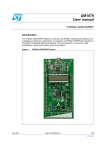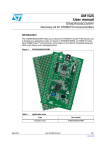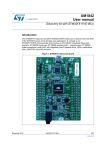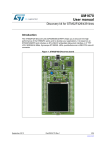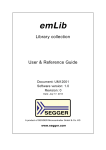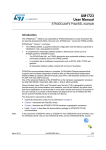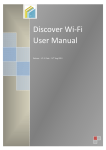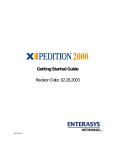Download Discovery kit for STM32F407/417 lines
Transcript
UM1472
User manual
Discovery kit for STM32F407/417 lines
Introduction
The STM32F4DISCOVERY helps you to discover the STM32F407 & STM32F417 lines’
high-performance features and to develop your applications.
It is based on an STM32F407VGT6 and includes an ST-LINK/V2 embedded debug tool
interface, ST MEMS digital accelerometer, ST MEMS digital microphone, audio DAC with
integrated class D speaker driver, LEDs, pushbuttons and a USB OTG micro-AB connector.
Figure 1. STM32F4DISCOVERY
1. Picture not contractual
January 2014
DocID022256 Rev 4
1/42
www.st.com
Contents
UM1472
Contents
1
Conventions . . . . . . . . . . . . . . . . . . . . . . . . . . . . . . . . . . . . . . . . . . . . . . . . 5
2
Quick start . . . . . . . . . . . . . . . . . . . . . . . . . . . . . . . . . . . . . . . . . . . . . . . . . 6
2.1
Getting started . . . . . . . . . . . . . . . . . . . . . . . . . . . . . . . . . . . . . . . . . . . . . . 6
2.2
System requirements . . . . . . . . . . . . . . . . . . . . . . . . . . . . . . . . . . . . . . . . . 6
2.3
Development toolchain supporting the STM32F4DISCOVERY . . . . . . . . . 6
2.4
Order code . . . . . . . . . . . . . . . . . . . . . . . . . . . . . . . . . . . . . . . . . . . . . . . . . 6
3
Features . . . . . . . . . . . . . . . . . . . . . . . . . . . . . . . . . . . . . . . . . . . . . . . . . . . 7
4
Hardware and layout . . . . . . . . . . . . . . . . . . . . . . . . . . . . . . . . . . . . . . . . . 8
4.1
STM32F407VGT6 microcontroller . . . . . . . . . . . . . . . . . . . . . . . . . . . . . . 11
4.2
Embedded ST-LINK/V2 . . . . . . . . . . . . . . . . . . . . . . . . . . . . . . . . . . . . . . 13
4.2.1
Using ST-LINK/V2 to program/debug the STM32F4 on board . . . . . . . 14
4.2.2
Using ST-LINK/V2 to program/debug an external STM32 application . . 15
4.3
Power supply and power selection . . . . . . . . . . . . . . . . . . . . . . . . . . . . . . 16
4.4
LEDs . . . . . . . . . . . . . . . . . . . . . . . . . . . . . . . . . . . . . . . . . . . . . . . . . . . . . 16
4.5
Pushbuttons . . . . . . . . . . . . . . . . . . . . . . . . . . . . . . . . . . . . . . . . . . . . . . . 16
4.6
On board audio capability . . . . . . . . . . . . . . . . . . . . . . . . . . . . . . . . . . . . . 17
4.7
USB OTG supported . . . . . . . . . . . . . . . . . . . . . . . . . . . . . . . . . . . . . . . . 17
4.8
Motion sensor (ST MEMS LIS302DL or LIS3DSH) . . . . . . . . . . . . . . . . . 17
4.9
JP1 (Idd) . . . . . . . . . . . . . . . . . . . . . . . . . . . . . . . . . . . . . . . . . . . . . . . . . . 18
4.10
OSC clock . . . . . . . . . . . . . . . . . . . . . . . . . . . . . . . . . . . . . . . . . . . . . . . . 19
4.10.1
OSC clock supply . . . . . . . . . . . . . . . . . . . . . . . . . . . . . . . . . . . . . . . . . 19
4.10.2
OSC 32 KHz clock supply . . . . . . . . . . . . . . . . . . . . . . . . . . . . . . . . . . . 19
4.11
Solder bridges . . . . . . . . . . . . . . . . . . . . . . . . . . . . . . . . . . . . . . . . . . . . . 20
4.12
Extension connectors . . . . . . . . . . . . . . . . . . . . . . . . . . . . . . . . . . . . . . . . 21
5
Mechanical drawing . . . . . . . . . . . . . . . . . . . . . . . . . . . . . . . . . . . . . . . . 34
6
Electrical schematics . . . . . . . . . . . . . . . . . . . . . . . . . . . . . . . . . . . . . . . 35
7
Revision history . . . . . . . . . . . . . . . . . . . . . . . . . . . . . . . . . . . . . . . . . . . 41
2/42
DocID022256 Rev 4
UM1472
List of tables
List of tables
Table 1.
Table 2.
Table 3.
Table 4.
Table 5.
Table 6.
ON/OFF conventions . . . . . . . . . . . . . . . . . . . . . . . . . . . . . . . . . . . . . . . . . . . . . . . . . . . . . . 5
Jumper states . . . . . . . . . . . . . . . . . . . . . . . . . . . . . . . . . . . . . . . . . . . . . . . . . . . . . . . . . . . 13
Debug connector CN2 (SWD). . . . . . . . . . . . . . . . . . . . . . . . . . . . . . . . . . . . . . . . . . . . . . . 15
Solder bridges. . . . . . . . . . . . . . . . . . . . . . . . . . . . . . . . . . . . . . . . . . . . . . . . . . . . . . . . . . . 20
MCU pin description versus board function . . . . . . . . . . . . . . . . . . . . . . . . . . . . . . . . . . . . 21
Document revision history. . . . . . . . . . . . . . . . . . . . . . . . . . . . . . . . . . . . . . . . . . . . . . . . . . 41
DocID022256 Rev 4
3/42
3
List of figures
UM1472
List of figures
Figure 1.
Figure 2.
Figure 3.
Figure 4.
Figure 5.
Figure 6.
Figure 7.
Figure 8.
Figure 9.
Figure 10.
Figure 11.
Figure 12.
Figure 13.
Figure 14.
Figure 15.
Figure 16.
4/42
STM32F4DISCOVERY . . . . . . . . . . . . . . . . . . . . . . . . . . . . . . . . . . . . . . . . . . . . . . . . . . . . . 1
Hardware block diagram . . . . . . . . . . . . . . . . . . . . . . . . . . . . . . . . . . . . . . . . . . . . . . . . . . . 8
Top layout . . . . . . . . . . . . . . . . . . . . . . . . . . . . . . . . . . . . . . . . . . . . . . . . . . . . . . . . . . . . . . 9
Bottom layout . . . . . . . . . . . . . . . . . . . . . . . . . . . . . . . . . . . . . . . . . . . . . . . . . . . . . . . . . . . 10
STM32F407VGT6 package . . . . . . . . . . . . . . . . . . . . . . . . . . . . . . . . . . . . . . . . . . . . . . . . 11
STM32F407VGT6 block diagram . . . . . . . . . . . . . . . . . . . . . . . . . . . . . . . . . . . . . . . . . . . 12
Typical configuration . . . . . . . . . . . . . . . . . . . . . . . . . . . . . . . . . . . . . . . . . . . . . . . . . . . . . 13
STM32F4DISCOVERY connections image . . . . . . . . . . . . . . . . . . . . . . . . . . . . . . . . . . . . 14
ST-Link connections image. . . . . . . . . . . . . . . . . . . . . . . . . . . . . . . . . . . . . . . . . . . . . . . . . 15
STM32F4DISCOVERY mechanical drawing . . . . . . . . . . . . . . . . . . . . . . . . . . . . . . . . . . . 34
STM32F4DISCOVERY . . . . . . . . . . . . . . . . . . . . . . . . . . . . . . . . . . . . . . . . . . . . . . . . . . . . 35
ST-LINK/V2 (SWD only) . . . . . . . . . . . . . . . . . . . . . . . . . . . . . . . . . . . . . . . . . . . . . . . . . . . 36
MCU . . . . . . . . . . . . . . . . . . . . . . . . . . . . . . . . . . . . . . . . . . . . . . . . . . . . . . . . . . . . . . . . . . 37
Audio. . . . . . . . . . . . . . . . . . . . . . . . . . . . . . . . . . . . . . . . . . . . . . . . . . . . . . . . . . . . . . . . . . 38
USB_OTG_FS . . . . . . . . . . . . . . . . . . . . . . . . . . . . . . . . . . . . . . . . . . . . . . . . . . . . . . . . . . 39
Peripherals . . . . . . . . . . . . . . . . . . . . . . . . . . . . . . . . . . . . . . . . . . . . . . . . . . . . . . . . . . . . . 40
DocID022256 Rev 4
UM1472
1
Conventions
Conventions
Table 1 provides the definition of some conventions used in the present document.
Table 1. ON/OFF conventions
Convention
Definition
Jumper JP1 ON
Jumper fitted
Jumper JP1 OFF
Jumper not fitted
Solder bridge SBx ON
SBx connections closed by solder
Solder bridge SBx OFF SBx connections left open
DocID022256 Rev 4
5/42
41
Quick start
2
UM1472
Quick start
The STM32F4DISCOVERY is a low-cost and easy-to-use development kit to quickly
evaluate and start a development with an STM32F4 high-performance microcontroller.
Before installing and using the product, please accept the Evaluation Product License
Agreement from www.st.com/stm32f4-discovery.
For more information on the STM32F4DISCOVERY and for demonstration software, visit
www.st.com/stm32f4-discovery.
2.1
Getting started
Follow the sequence below to configure the STM32F4DISCOVERY board and launch the
DISCOVER application:
1. Check jumper position on the board, JP1 on, CN3 on (DISCOVERY selected).
2. Connect the STM32F4DISCOVERY board to a PC with a USB cable ‘type A to mini-B’
through USB connector CN1 to power the board. Red LED LD2 (PWR) then lights up.
3. Four LEDs between B1 and B2 buttons are blinking.
4. Press user button B1 to enable the ST MEMS sensor, move the board and observe the
four LEDs blinking according to the motion direction and speed. (If you connect a
second USB cable ‘type A to micro-B’ between PC and CN5 connector then the board
is recognized as standard mouse and its motion will also control the PC cursor).
5. To study or modify the DISCOVER project related to this demo, visit
www.st.com/stm32f4-discovery and follow the tutorial.
6. Discover the STM32F4 features, download and execute programs proposed in the list
of projects.
7. Develop your own application using available examples.
2.2
System requirements
•
•
2.3
Development toolchain supporting the STM32F4DISCOVERY
•
•
•
•
2.4
Windows PC (XP, Vista, 7)
USB type A to Mini-B USB cable
Altium, TASKING™ VX-Toolset
Atollic TrueSTUDIO®
IAR Embedded Workbench® for ARM (EWARM)
Keil™, MDK-ARM
Order code
To order the STM32F4 high-performance discovery board, use the order code
STM32F4DISCOVERY.
6/42
DocID022256 Rev 4
UM1472
3
Features
Features
The STM32F4DISCOVERY offers the following features:
•
STM32F407VGT6 microcontroller featuring 1 MB of Flash memory, 192 KB of RAM in
an LQFP100 package
•
On-board ST-LINK/V2 with selection mode switch to use the kit as a standalone
ST-LINK/V2 (with SWD connector for programming and debugging)
•
Board power supply: through USB bus or from an external 5V supply voltage
•
External application power supply: 3V and 5V
•
LIS302DL or LIS3DSH, ST MEMS motion sensor, 3-axis digital output accelerometer
•
MP45DT02, ST MEMS audio sensor, omnidirectional digital microphone
•
CS43L22, audio DAC with integrated class D speaker driver
•
Eight LEDs:
–
LD1 (red/green) for USB communication
–
LD2 (red) for 3.3V power on
–
Four user LEDs, LD3 (orange), LD4 (green), LD5 (red) and LD6 (blue)
–
2 USB OTG LEDs LD7 (green) VBus and LD8 (red) over-current
•
Two pushbuttons (user and reset)
•
USB OTG with micro-AB connector
•
Extension header for LQFP100 I/Os for quick connection to prototyping board and easy
probing
DocID022256 Rev 4
7/42
41
Hardware and layout
4
UM1472
Hardware and layout
The STM32F4DISCOVERY is designed around the STM32F407VGT6 microcontroller in a
100-pin LQFP package.
Figure 2 illustrates the connections between the STM32F407VGT6 and its peripherals (STLINK/V2, pushbutton, LED, Audio DAC, USB, ST MEMS accelerometer, ST MEMS
microphone, and connectors).
Figure 3 and Figure 4 help you to locate these features on the STM32F4DISCOVERY.
Figure 2. Hardware block diagram
0LQL
86%
6:'
(PEHGGHG
67/,1.9
670)9*7
,2
5(6(7
/('
/'WR/'
%
567
03'7
%
86(5
&6/
0LQL-DFN
+HDGHU
,2
+HDGHU
,2
/,6'/RU
/,6'6+
0LFUR86%
069
8/42
DocID022256 Rev 4
UM1472
Hardware and layout
Figure 3. Top layout
67/,1.9
/'UHGJUHHQ/('
&20
&1
6:'FRQQHFWRU
/'UHG/('
3:5
5
'
&1
/'
5
5
5
5
5
5
&
&
&20
'
&1
&
8
&
5
&
67/,1.
8
&
5
&
5
'
&1
5
5
&
',6&29(5<
5
&
5
&
5
5
6:'
;
&
5
3:5
/'
5
5
&
&
&
&
&
&
&
5
5
9''
*1'
1567
3&
3&
3&
3&
3$
3$
3$
3$
3$
3$
3$
3$
&
;
5
&
&
&
/
&
5
5
8
5
&
&
&
&
&
5
9''
3
;
5
*1'
&
*1'
&
8
5
&
ZZZVWFRPVWPIGLVFRYHU\
3
-3
5
,GG
5
670)9*7
5
5
5
*1'
*1'
9
9
9
9
3+
3+
3&
3&
3(
3&
3(
3(
3(
3(
3(
3(
&
&
5
%
8
/'
%
3%
3%
3%
3%
3%
3'
3'
3'
3'
3'
&1
&
3'
3'
3'
1&
5
5
5
8
&
5
8
5HVHW
5
5
&
&
5
&
5
3%
5
5
&
&
5
&
&
&
5
8
5
5
5
&
5
5
&
5
3%
9''
3%
3%
3%
3%
3'
3%
3'
3'
3'
3'
3'
3'
3&
3'
3&
3&
3$
3$
3$
3$
3$
3$
3&
3&
3&
5
/'
&
8
3&
*1'
*1'
/'
*1'
9SRZHU
VXSSO\RXWSXW
6%%5(6(7
/'
RUDQJH/('
/'UHG/('
%UHVHWEXWWRQ
7
&1
5
3%
%227
9SRZHU
VXSSO\LQSXWRXWSXW
&
5
3(
3(
/'
5
3(
8VHU
5
3(
&
3(
&
&
3(
5
&
3(
/'
5
JUHHQ/('/'
&
/'
5
5
3(
5
&
5
5
3%
5
&
*1'
3(
6%
&
&
3%
&
EOXH/('/'
3&
3%
&
JUHHQ/('/'
3&
&
%XVHUEXWWRQ
&1
67/,1.',6&29(5<
VHOHFWRU
5
&
-3
,''PHDVXUHPHQW
0%&
*1'
5
/'UHG/('
069
Note:
Pin 1 of CN2, CN3, JP1, P1 and P2 connectors are identified by a square.
DocID022256 Rev 4
9/42
41
Hardware and layout
UM1472
Figure 4. Bottom layout
3"3"3"3"
2%3%26%$
3".234
3"3"3"3"
$%&!5,4
3"34-?234
3"8CRYSTAL
3"8CRYSTAL
3"37/
3"8CRYSTAL
3"8CRYSTAL
3"6$$FROM6
3""//4
3""//4
3""53%2
-36
10/42
DocID022256 Rev 4
UM1472
4.1
Hardware and layout
STM32F407VGT6 microcontroller
This ARM Cortex-M4 32-bit MCU with FPU has 210 DMIPS, up to 1 MB Flash/192+4 KB
RAM, USB OTG HS/FS, Ethernet, 17 TIMs, 3 ADCs, 15 comm. interfaces and a camera.
Figure 5. STM32F407VGT6 package
34-&6'4
-BYTEOF&LASHMEMORY
+BYTESOF2!-
,1&0XMM
-36
This device provides the following benefits.
•
168 MHz/210 DMIPS Cortex-M4 with single cycle DSP MAC and floating point unit
providing:
Boosted execution of control algorithms
More features possible for your applications
Ease of use
Better code efficiency
Faster time to market
Elimination of scaling and saturation
Easier support for meta-language tools
•
Designed for high performance and ultra fast data transfers; ART Accelerator, 32-bit, 7layer AHB bus matrix with 7 masters and 8 slaves including 2 blocks of SRAM, Multi
DMA controllers: 2 general purpose, 1 for USB HS, 1 for Ethernet, One SRAM block
dedicated to the core, providing performance equivalent to 0-wait execution from Flash
Concurrent execution and data transfers and simplified resource allocation
•
Outstanding power efficiency; Ultra-low dynamic power, RTC <1 μA typical in VBAT
mode, 3.6 V down to 1.7 V VDD, Voltage regulator with power scaling capability,
providing extra flexibility to reduce power consumption for applications requiring both
high processing and low power performance when running at low voltage or on a
rechargeable battery
•
Maximum integration: Up to 1 Mbyte of on-chip Flash memory, 192 Kbytes of SRAM,
reset circuit, internal RCs, PLLs, WLCSP package available, providing more features in
space constrained applications
•
Superior and innovative peripherals providing new possibilities to connect and
communicate high speed data and more precision due to high resolution
•
Extensive tools and software solutions providing a wide choice within the STM32
ecosystem to develop your applications.
DocID022256 Rev 4
11/42
41
Hardware and layout
UM1472
Figure 6. STM32F407VGT6 block diagram
%XTERNALMEMORY
CONTROLLER&3-#
##-DATA2!-+"
*4!'37
-05
.6)#
%4-
$"53
53"
/4'(3
3TREAMS
$-!
32!-+"
32!-+"
!("-(Z
&)&/
!(
("-(Z
3TREAMS
$-!
2.'
6$$
6$$!
0!;=
0";=
'0)/0/24!
'0)/0/24"
0#;=
'0)/0/24#
0$;=
'0)/0/24$
0%;=
'0)/0/24%
53"
/4'&3
2#(3
0/2
2ESET
2#,3
)NT
0,,
3UPPLY
SUPERVISION
0/20$2
"/2
06$
,3
0#,+X
'0)/0/24(
6#!06#!0
6$$!633!
.234
/3#?).
/3#?/54
6"!4TO6
6"!4
84!,K(Z
24#
'0)/0/24)
,3
0);=
'0)/0/24'
6$$TO6
633
)7$'
3TANDBY
INTERFACE
&#,+
0(;=
'0)/0/24&
(#,+X
0';=
84!,/3#
-(Z
2ESET
CLOCK
-!.!'4
CONTROL
$0
$3#,3$!).4.)$6"533/&
6$$
6$$!
0&;=
(39.#639.#
0)8#,+$;=
0OWERMANAGMT
6OLTAGE
REGULATOR
6TO6
6$$
&)&/
#AMERA
INTERFACE
0(9
$-!
&)&/
&LASH
UPTO
-"
&)&/
%THERNET-!# $-!
&)&/
0(9
$0$5,0)#+$$)2340.84
3#,3$!).4.)$6"533/&
3"53
&)&/
!2-#ORTEX-&
-(Z
)"53
&05
-))OR2-))AS!&
-$)/AS!&
#,+.%;=!;=
$;=/%.7%.
.",;=.,.2%'
.7!)4)/2$9#$
.)/2$)/72).4;=
).4..))3AS!&
32!-032!-./2&LASH
0##ARD!4!.!.$&LASH
!24!##%,
#!#(%
42!#%#,+
42!#%$;=
!("
!("BUSMATRIX3-
.*4234*4$)
*4#+37#,+
*4$/37$*4$/
!75
"ACKUP REGISTER
/3#?).
/3#?/54
24#?!&
24#?!&
+""+032!-
4)- B
$-!
$-!
4)-
!("!0" !("!0"
CHANNELAS!&
4)- B
4)-07- B
4)-
53!24
SMCARD
IR$!
2848#+
#43243AS!&
5!24
2848AS!&
5!24
2848AS!&
4)-
SMCARD
53!24
IR$!
30)
4)-
4)-
B
B
6$$!
53!24-"PS
4EMPERATURESENSOR
6$$!
!$#
!$#
!$#
$!#
)&
)4&
30))3
-/3)3$-)3/3$?EXT 3#+#+
.3373-#+AS!&
30))3
-/3)3$-)3/3$?EXT 3#+#+
.3373-#+AS!&
3#,3$!3-"!AS!&
)#3-"53
3#,3$!3-"!AS!&
BX#!.
BX#!.
$!#?/54
AS!&
DocID022256 Rev 4
3#,3$!3-"!AS!&
)#3-"53
)#3-"53
$!#
$!#?/54
AS!&
12/42
2848#+
#43243AS!&
B
2848#+
#43243AS!&
ANALOGINPUTSCOMMON
TOTHE!$#S
ANALOGINPUTSCOMMON
TOTHE!$#
ANALOGINPUTSTO!$#
SMCARD
IR$!
4)- B
2848#+
#43243AS!&
6$$2%&?!$#
CHANNEL AS!&
53!24
77$'
B
SMCARD
53!24
IR$!
-/3)-)3/
3#+.33AS!&
CHANNEL AS!&
4)- B
B
4)-07-
CHANNELSAS!&
&)&/
CHANNELAS!&
CHANNELS%42AS!&
B
3$)/--#
!0"-(Z
!0"-(ZMAX
COMPLCHANNELS4)-?#(;=.
CHANNELS4)-?#(;=%42
"+).AS!&
COMPLCHANNELS4)-?#(;=.
CHANNELS4)-?#(;=%42
"+).AS!&
CHANNELSAS!&
CHANNELS%42AS!&
B
4)-
!0"-(Z
!0" -(Z
$;=
#-$#+AS!&
4)-
CHANNELS%42AS!&
B
%84)47+50
&)&/
!&
CHANNELS%42AS!&
B
4)-
4828
4828
-36
UM1472
4.2
Hardware and layout
Embedded ST-LINK/V2
The ST-LINK/V2 programming and debugging tool is integrated on the
STM32F4DISCOVERY. The embedded ST-LINK/V2 can be used in 2 different ways
according to the jumper states (see Table 2):
•
Program/debug the MCU on board,
•
Program/debug an MCU in an external application board using a cable connected to
SWD connector CN2.
The embedded ST-LINK/V2 supports only SWD for STM32 devices. For information about
debugging and programming features refer to user manual UM1075 (ST-LINK/V2 in-circuit
debugger/programmer for STM8 and STM32) which describes in detail all the ST-LINK/V2
features.
Figure 7. Typical configuration
(ARDWAREREQUIREMENTS
53"CABLETYPE!TOMINI"
COMPUTERWITH7INDOWS806ISTAOR
$EVELOPMENTTOOLCHAIN
!LTIUM4!3+).'684OOLSET
!TOLLIC4RUE345$)/
)!2%7!2+EIL-$+!2-
-36
Table 2. Jumper states
Jumper state
Description
Both CN3 jumpers ON
ST-LINK/V2 functions enabled for on board programming (default)
Both CN3 jumpers OFF
ST-LINK/V2 functions enabled for application through external CN2
connector (SWD supported)
DocID022256 Rev 4
13/42
41
Hardware and layout
4.2.1
UM1472
Using ST-LINK/V2 to program/debug the STM32F4 on board
To program the STM32F4 on board, simply plug in the two jumpers on CN3, as shown in
Figure 8 in red, but do not use the CN2 connector as that could disturb communication with
the STM32F407VGT6 of the STM32F4DISCOVERY.
Figure 8. STM32F4DISCOVERY connections image
&1
6:'FRQQHFWRU
&1
-XPSHUV21
06Y9
14/42
DocID022256 Rev 4
UM1472
4.2.2
Hardware and layout
Using ST-LINK/V2 to program/debug an external STM32 application
It is very easy to use the ST-LINK/V2 to program the STM32 on an external application.
Simply remove the 2 jumpers from CN3 as shown in Figure 9, and connect your application
to the CN2 debug connector according to Table 3.
Note:
SB11 must be OFF if you use CN2 pin 5 in your external application.
Table 3. Debug connector CN2 (SWD)
Pin
CN2
Designation
1
VDD_TARGET
VDD from application
2
SWCLK
SWD clock
3
GND
Ground
4
SWDIO
SWD data input/output
5
NRST
RESET of target MCU
6
SWO
Reserved
Figure 9. ST-Link connections image
&1
6:'FRQQHFWRU
&1
-XPSHUV2))
06Y9
DocID022256 Rev 4
15/42
41
Hardware and layout
4.3
UM1472
Power supply and power selection
The power supply is provided either by the host PC through the USB cable, or by an
external 5V power supply.
The D1 and D2 diodes protect the 5V and 3V pins from external power supplies:
•
5V and 3V can be used as output power supplies when another application board is
connected to pins P1 and P2.
In this case, the 5V and 3V pins deliver a 5V or 3V power supply and power
consumption must be lower than 100 mA.
•
5V can also be used as input power supplies e.g. when the USB connector is not
connected to the PC.
In this case, the STM32F4DISCOVERY board must be powered by a power supply unit
or by auxiliary equipment complying with standard EN-60950-1: 2006+A11/2009, and
must be Safety Extra Low Voltage (SELV) with limited power capability.
4.4
LEDs
•
•
•
•
•
•
•
•
4.5
Pushbuttons
•
•
16/42
LD1 COM: LD1 default status is red. LD1 turns to green to indicate that
communications are in progress between the PC and the ST-LINK/V2.
LD2 PWR: red LED indicates that the board is powered.
User LD3: orange LED is a user LED connected to the I/O PD13 of the
STM32F407VGT6.
User LD4: green LED is a user LED connected to the I/O PD12 of the
STM32F407VGT6.
User LD5: red LED is a user LED connected to the I/O PD14 of the STM32F407VGT6.
User LD6: blue LED is a user LED connected to the I/O PD15 of the STM32F407VGT6.
USB LD7: green LED indicates when VBUS is present on CN5 and is connected to
PA9 of the STM32F407VGT6.
USB LD8: red LED indicates an overcurrent from VBUS of CN5 and is connected to the
I/O PD5 of the STM32F407VGT6.
B1 USER: User and Wake-Up button connected to the I/O PA0 of the
STM32F407VGT6.
B2 RESET: Pushbutton connected to NRST is used to RESET the STM32F407VGT6.
DocID022256 Rev 4
UM1472
4.6
Hardware and layout
On board audio capability
The STM32F4 uses an audio DAC (CS43L22) to output sounds through the audio mini jack
connector.
The STM32F4 controls the audio DAC through the I2C interface and processes digital
signals through I2S connection or analog input signal.
•
The sound can come independently from different inputs:
–
ST MEMS microphone (MP45DT02): digital using PDM protocol or analog when
using the low pass filter.
–
USB connector: from external mass storage such as a USB key, USB HDD, and
so on.
–
Internal memory of the STM32F4.
•
The sound can be output in different ways through audio DAC:
–
Using I2S protocol
–
Using the STM32F4 DAC to analog input AIN1x of the CS43L22
–
Using the microphone output directly via a low pass filter to analog input AIN4x of
the CS43L22
4.7
USB OTG supported
The STM32F4 is used to drive only USB OTG full speed on this board. The USB micro-AB
connector (CN5) allows the user to connect a host or device component, such as a USB
key, mouse, and so on.
Two LEDs are dedicated to this module:
•
LD7 (green LED) indicates when VBUS is active
•
LD8 (red LED) indicates an overcurrent from connected device
4.8
Motion sensor (ST MEMS LIS302DL or LIS3DSH)
Two different versions of motion sensor (U5 in schematic) are available on the board
depending the PCB version. The LIS302DL is present on board MB997B (PCB revision B)
and the LIS3DSH is present on board MB997C (PCB rev C).
The LIS302DL or LIS3DSH are both an ultra compact low-power three-axis linear
accelerometer.
It includes a sensing element and an IC interface able to provide the measured acceleration
to the external world through I2C/SPI serial interface.
The LIS302DL has dynamically user selectable full scales of +-2g/+-8g and it is capable of
measuring acceleration with an output rate of 100Hz to 400Hz.
The LIS3DSH has ±2g/±4g/±6g/±8g/±16g dynamically selectable full-scale and it is capable
of measuring acceleration with an output data rate of 3.125 Hz to 1.6 kHz.
The STM32F4 controls this motion sensor through the SPI interface.
DocID022256 Rev 4
17/42
41
Hardware and layout
4.9
UM1472
JP1 (Idd)
Jumper JP1, labeled Idd, allows the consumption of STM32F407VGT6 to be measured by
removing the jumper and connecting an ammeter.
•
Jumper on: STM32F407VGT6 is powered (default).
•
Jumper off: an ammeter must be connected to measure the STM32F407VGT6 current,
(if there is no ammeter, the STM32F407VGT6 is not powered).
18/42
DocID022256 Rev 4
UM1472
Hardware and layout
4.10
OSC clock
4.10.1
OSC clock supply
If PH0 and PH1 are only used as GPIOs instead of as a clock, then SB13 and SB14 are
closed and R24, R25 and R68 are removed.
•
MCO from ST-LINK. From MCO of the STM32F103. This frequency cannot be
changed, it is fixed at 8 MHz and connected to PH0-OSC_IN of the STM32F407VGT6.
Configuration needed:
–
SB13, SB14 OPEN
–
R25(a) removed
–
R68(a) soldered
•
Oscillator onboard. From X2 crystal. For typical frequencies and its capacitors and
resistors, please refer to the STM32F407VGT6 Datasheet. Configuration needed:
–
SB13, SB14 OPEN
–
R25(a) soldered
–
R68(a) removed
•
Oscillator from external PH0. From external oscillator through pin 7 of the P2
connector. Configuration needed:
–
SB13 closed
–
SB14 closed
–
R25 and R68 removed
4.10.2
OSC 32 KHz clock supply
If PC14 and PC15 are only used as GPIOs instead of as a clock, then SB15 and SB16 are
closed, and R21 and R22 are removed.
•
Oscillator onboard. From X1 Crystal (not provided). Configuration needed:
–
SB15, SB16 OPEN
–
C16, C27, R21 and R22 soldered.
•
Oscillator from external PC14. From external oscillator trough the pin 9 of P2
connector. Configuration needed:
–
SB16 closed
–
SB15 closed
–
R21 and R22 removed
a. As the frequency supplied by X2 is the same as MCO (8 MHz) R25 and R68 are soldered.
DocID022256 Rev 4
19/42
41
Hardware and layout
4.11
UM1472
Solder bridges
Table 4. Solder bridges
State(1)
Bridge
Description
OFF
X2, C14, C15, R24 and R25 provide a clock.
PH0, PH1 are disconnected from P2.
ON
PH0, PH1 are connected to P2 (R24, R25 and R68 must not be fitted).
SB3,5,7,9 (Default)
ON
Reserved, do not modify.
SB2,4,6,8 (Reserved)
OFF
Reserved, do not modify.
SB15,16
(X3 crystal)
OFF
X3, C16, C27, R21 and R22 deliver a 32 KHz clock.
PC14, PC15 are not connected to P2.
ON
PC14, PC15 are only connected to P2. Remove only R21, R22
SB1
(B2-RESET)
ON
B2 pushbutton is connected to the NRST pin of the STM32F407VGT6 MCU.
OFF
B2 pushbutton is not connected the NRST pin of the STM32F407VGT6 MCU.
SB20
(B1-USER)
ON
B1 pushbutton is connected to PA0.
OFF
B1 pushbutton is not connected to PA0.
SB17
(VDD powered from
3V)
OFF
VDD is not powered from 3V, depends on JP1 jumper.
ON
VDD is permanently powered from 3V, JP1 jumper has no effect.
ON
NRST signal of the CN2 connector is connected to the NRST pin of the
STM32F407VGT6 MCU.
OFF
NRST signal of the CN2 connector is not connected to the NRST pin of the
STM32F407VGT6 MCU.
ON
SWO signal of the CN2 connector is connected to PB3.
OFF
SWO signal is not connected.
OFF
No incidence on STM32F103C8T6 (ST-LINK/V2) NRST signal.
ON
STM32F103C8T6 (ST-LINK/V2) NRST signal is connected to GND.
ON
BOOT0 signal of the STM32F407VGT6 MCU is held low through a 510 ohm
pull-down resistor.
OFF
BOOT0 signal of the STM32F407VGT6 MCU is held high through a 10 Kohm
pull-up resistor.
OFF
The BOOT1 signal of the STM32F407VGT6 MCU is held high through a
10 Kohm pull-up resistor.
ON
The BOOT1 signal of the STM32F407VGT6 MCU is held low through a 510 ohm
pull-down resistor.
SB13,14 (X2 crystal)
(2)
SB11 (NRST)
SB12 (SWO)
SB10 (STM_RST)
SB18 (BOOT0)
SB19 (BOOT1)
1. Default SBx state is shown in bold.
2. SB13 and SB14 are OFF to allow the user to choose between MCO and X2 crystal for clock source.
20/42
DocID022256 Rev 4
UM1472
4.12
Hardware and layout
Extension connectors
The male headers P1 and P2 can connect the STM32F4DISCOVERY to a standard
prototyping/wrapping board. STM32F407VGT6 GPI/Os are available on these connectors.
P1 and P2 can also be probed by an oscilloscope, logical analyzer or voltmeter.
Table 5. MCU pin description versus board function
MCU pin
Board function
CS43L22
MP45DT02
LIS302DL or LIS3DSH
Pushbutton
LED
SWD
USB
OSC
Free I/O
Power supply
CN5
CN2
P1
P2
-
-
-
-
-
-
-
-
-
-
-
-
-
21
14
-
-
-
RESET
-
NRST
-
-
-
-
-
5
6
-
PA0WKUP
USART2_CTS/
USART4_TX/
ETH_MII_CRS/
TIM2_CH1_ETR/
TIM5_CH1/
TIM8_ETR/
ADC123_IN0/
WKUP
23
-
-
-
USER
-
-
-
-
-
-
-
-
12
-
PA1
USART2_RTS/
USART4_RX/
ETH_RMII_REF_CLK/
ETH_MII_RX_CLK/
TIM5_CH2/
TIMM2_CH2/
ADC123_IN1
24
-
-
-
-
-
-
-
-
-
-
-
-
11
-
PA2
USART2_TX/
TIM5_CH3/
TIM9_CH1/
TIM2_CH3/
ETH_MDIO/
ADC123_IN2
25
-
-
-
-
-
-
-
-
-
-
-
-
14
-
BOOT0
NRST
VPP
-
LQFP100
94
Alternate
functions
Main
function
DocID022256 Rev 4
21/42
41
Hardware and layout
UM1472
Table 5. MCU pin description versus board function (continued)
MCU pin
Board function
CS43L22
MP45DT02
LIS302DL or LIS3DSH
Pushbutton
LED
SWD
USB
OSC
Free I/O
Power supply
CN5
CN2
P1
P2
26
-
-
-
-
-
-
-
-
-
-
-
-
13
-
PA4
SPI1_NSS/
SPI3_NSS/
USART2_CK/
DCMI_HSYNC/
OTG_HS_SOF/
I2S3_WS/
ADC12_IN4/
DAC1_OUT
29
LRCK/AIN1x
-
-
-
-
-
-
-
-
-
-
-
16
-
PA5
SPI1_SCK/
OTG_HS_ULPI_CK/
TIM2_CH1_ETR/
TIM8_CHIN/
ADC12_IN5/
DAC2_OUT
30
-
-
SCL/SPC
-
-
-
-
-
-
-
-
-
15
-
PA6
SPI1_MISO/
TIM8_BKIN/
TIM13_CH1/
DCMI_PIXCLK/
TIM3_CH1/
TIM1_BKIN/
ADC12_IN6
31
-
-
SDO
-
-
-
-
-
-
-
-
-
18
-
PA7
SPI1_MOSI/
TIM8_CH1N/
TIM14_CH1TIM3_CH2/
32
ETH_MII_RX_DV/
TIM1_CH1N/
RMII_CRS_DV/
ADC12_IN7
-
-
SDA/SDI/SDO
-
-
-
-
-
-
-
-
-
17
-
22/42
Alternate
functions
LQFP100
PA3
USART2_RX/
TIM5_CH4/
TIM9_CH2/
TIM2_CH4/
OTG_HS_ULPI_D0/
ETH_MII_COL/
ADC123_IN3
Main
function
DocID022256 Rev 4
UM1472
Hardware and layout
Table 5. MCU pin description versus board function (continued)
MCU pin
Board function
MP45DT02
LIS302DL or LIS3DSH
Pushbutton
LED
SWD
USB
OSC
Free I/O
Power supply
CN5
CN2
P1
P2
-
-
-
-
-
-
-
-
-
-
-
-
-
43
PA9
USART1_TX/
TIM1_CH2/
I2C3_SMBA/
DCMI_D0/
OTG_FS_VBUS
68
-
-
-
-
GREEN
-
VBUS
-
-
-
1
-
-
44
PA10
USART1_RX/
TIM1_CH3/
OTG_FS_ID/
DCMI_D1
69
-
-
-
-
-
-
ID
-
-
-
4
-
-
41
PA11
USART1_CTS/
CAN1_RX/
TIM1_CH4/
OTG_FS_DM
70
-
-
-
-
-
-
DM
-
-
-
2
-
-
-
PA12
USART1_RTS/
CAN1_TX/
TIM1_ETR/
OTG_FS_DP
71
-
-
-
-
-
-
DP
-
-
-
3
-
-
-
PA13
JTMS-SWDIO
72
-
-
-
-
-
-
-
-
-
-
4
-
42
PA14
JTCK-SWCLK
76
-
-
-
-
-
-
-
-
-
-
2
-
39
PA15
JTDI/
SPI3_NSS/
I2S3_WS/
TIM2_CH1_ETR/
SPI1_NSS
77
-
-
-
-
-
-
-
-
-
-
-
-
40
DocID022256 Rev 4
SWDIO SWCLK
CS43L22
67
Alternate
functions
LQFP100
PA8
MCO1/
USART1_CK/
TIM1_CH1/
I2C3_SCL/
OTG_FS_SOF
Main
function
-
23/42
41
Hardware and layout
UM1472
Table 5. MCU pin description versus board function (continued)
MCU pin
Board function
CS43L22
MP45DT02
LIS302DL or LIS3DSH
Pushbutton
LED
SWD
USB
OSC
Free I/O
Power supply
CN5
CN2
P1
P2
35
-
-
-
-
-
-
-
-
-
-
-
-
22
-
PB1
TIM3_CH4/
TIM8_CH3N/
OTG_HS_ULPI_D2/
ETH_MII_RXD3/
OTG_HS_INTN/
TIM1_CH3N/
ADC12_IN9
36
-
-
-
-
-
-
-
-
-
-
-
-
21
-
37
-
-
-
-
-
-
-
-
-
-
-
-
24
-
PB3
JTDO/
TRACESWO/
SPI3_SCK/
I2S3_CK/
TIM2_CH2/
SPI1_SCK
89
-
-
-
-
-
SWO
-
-
-
-
-
6
PB4
NJTRST/
SPI3_MISO/
TIM3_CH1/
SPI1_MISO/
I2S3ext_SD
90
-
-
-
-
-
-
-
-
-
-
-
-
-
25
PB5
I2C1_SMBA/
CAN2_RX/
OTG_HS_ULPI_D7/
ETH_PPS_OUT/
TIM3_CH2/
SPI1_MOSI/
SPI3_MOSI/
DCMI_D10/
I2S3_SD
91
-
-
-
-
-
-
-
-
-
-
-
-
-
26
PB2
24/42
Alternate
functions
-
LQFP100
PB0
TIM3_CH3/
TIM8_CH2N/
OTG_HS_ULPI_D1/
ETH_MII_RXD2/
TIM1_CH2N/
ADC12_IN8
Main
function
DocID022256 Rev 4
28
UM1472
Hardware and layout
Table 5. MCU pin description versus board function (continued)
MCU pin
Board function
CS43L22
MP45DT02
LIS302DL or LIS3DSH
Pushbutton
LED
SWD
USB
OSC
Free I/O
Power supply
CN5
CN2
P1
P2
SCL
-
-
-
-
-
-
-
-
-
-
-
23
-
-
-
-
-
-
-
-
-
-
-
-
95
-
-
-
-
-
-
-
-
-
-
-
-
-
19
PB9
SPI2_NSS/
I2S2_WS/
TIM4_CH4/
TIM11_CH1/
OTG_FS_SDA/
SDIO_D5/
DCMI_D7/
I2C1_SDA/
CAN1_TX
96
SDA
-
-
-
-
-
-
-
-
-
-
-
-
20
PB10
SPI2_SCK/
I2S2_CK/
I2C2_SCL/
USART3_TX/
OTG_HS_ULPI_D3/
ETH_MII_RX_ER/
OTG_HS_SCL/
TIM2_CH3
47
-
CLK
-
-
-
-
-
-
-
-
-
-
34
-
Alternate
functions
LQFP100
-
Main
function
PB6
I2C1_SCL/
TIM4_CH1/
CAN2_TX/
OTG_FS_INTN/
DCMI_D5/
USART1_TX
92
PB7
I2C1_SDA/
FSMC_NL/
DCMI_VSYNC/
USART1_RX/
TIM4_CH2
93
PB8
TIM4_CH3/
SDIO_D4/
TIM10_CH1/
DCMI_D6/
OTG_FS_SCL/
ETH_MII_TXD3/
I2C1_SCL/
CAN1_RX
DocID022256 Rev 4
24
25/42
41
Hardware and layout
UM1472
Table 5. MCU pin description versus board function (continued)
MCU pin
Board function
CS43L22
MP45DT02
LIS302DL or LIS3DSH
Pushbutton
LED
SWD
USB
OSC
Free I/O
Power supply
CN5
CN2
P1
P2
48
-
-
-
-
-
-
-
-
-
-
-
-
35
-
PB12
SPI2_NSS/
I2S2_WS/
I2C2_SMBA/
USART3_CK/
TIM1_BKIN/
CAN2_RX/
OTG_HS_ULPI_D5/
ETH_RMII_TXD0/
ETH_MII_TXD0/
OTG_HS_ID
51
-
-
-
-
-
-
-
-
-
-
-
-
36
-
PB13
SPI2_SCK/
I2S2_CK/
USART3_CTS/
TIM1_CH1N/
CAN2_TX/
OTG_HS_ULPI_D6/
ETH_RMII_TXD1/
ETH_MII_TXD1/
OTG_HS_VBUS
52
-
-
-
-
-
-
-
-
-
-
-
-
37
-
PB14
SPI2_MISO/
TIM1_CH2N/
TIM12_CH1/
OTG_HS_DMUSART3
_RTS/
TIM8_CH2N/
I2S2ext_SD
53
-
-
-
-
-
-
-
-
-
-
-
-
38
-
26/42
Alternate
functions
LQFP100
PB11
I2C2_SDA/
USART3_RX/
OTG_HS_ULPI_D4/
ETH_RMII_TX_EN/
ETH_MII_TX_EN/
OTG_HS_SDA/
TIM2_CH4
Main
function
DocID022256 Rev 4
UM1472
Hardware and layout
Table 5. MCU pin description versus board function (continued)
MCU pin
Board function
CS43L22
MP45DT02
LIS302DL or LIS3DSH
Pushbutton
LED
SWD
USB
OSC
Free I/O
Power supply
CN5
CN2
P1
P2
54
-
-
-
-
-
-
-
-
-
-
-
-
39
-
PC0
OTG_HS_ULPI_STP/
ADC123_IN10
15
-
-
-
-
-
-
PowerOn
-
-
-
-
-
8
-
PC1
ETH_MDC/
ADC123_IN11
16
-
-
-
-
-
-
-
-
-
-
-
-
7
-
PC2
SPI2_MISO/
OTG_HS_ULPI_DIR/
TH_MII_TXD2/
I2S2ext_SD/
ADC123_IN12
17
-
-
-
-
-
-
-
-
-
-
-
-
10
-
PC3
SPI2_MOSI/
I2S2_SD/
OTG_HS_ULPI_NXT/
ETH_MII_TX_CLK/
ADC123_IN13
18
-
DOUT/AIN4x
-
-
-
-
-
-
-
-
-
-
9
-
PC4
ETH_RMII_RX_D0/
ETH_MII_RX_D0/
ADC12_IN14
33
-
-
-
-
-
-
-
-
-
-
-
-
20
-
PC5
ETH_RMII_RX_D1/
ETH_MII_RX_D1/
ADC12_IN15
34
-
-
-
-
-
-
-
-
-
-
-
-
19
-
PC6
I2S2_MCK/
TIM8_CH1/
SDIO_D6/
USART6_TX/
DCMI_D0/
TIM3_CH1
63
-
-
-
-
-
-
-
-
-
-
-
-
-
47
Alternate
functions
LQFP100
PB15
SPI2_MOSI/
I2S2_SD/
TIM1_CH3N/
TIM8_CH3N/
TIM12_CH2/
OTG_HS_DP
Main
function
DocID022256 Rev 4
27/42
41
Hardware and layout
UM1472
Table 5. MCU pin description versus board function (continued)
MCU pin
Board function
CS43L22
MP45DT02
LIS302DL or LIS3DSH
Pushbutton
LED
SWD
USB
OSC
Free I/O
Power supply
CN5
CN2
P1
P2
MCLK
-
-
-
-
-
-
-
-
-
-
-
48
-
-
-
-
-
-
-
-
-
-
-
-
-
45
66
-
-
-
-
-
-
-
-
-
-
-
-
-
46
PC10
SPI3_SCK/
I2S3_CK/
UART4_TX/
SDIO_D2/
DCMI_D8/
USART3_TX
78
SCLK
-
-
-
-
-
-
-
-
-
-
-
-
37
PC11
UART4_RX/
SPI3_MISO/
SDIO_D3/
DCMI_D4/
USART3_RX/
I2S3ext_SD
79
-
-
-
-
-
-
-
-
-
-
-
-
-
38
PC12
UART5_TX/
SDIO_CK/
DCMI_D9/
SPI3_MOSI/
I2S3_SD/
USART3_CK
80
SDIN
-
-
-
-
-
-
-
-
-
-
-
-
35
Alternate
functions
LQFP100
-
Main
function
PC7
I2S3_MCK/
TIM8_CH2/
SDIO_D7/
USART6_RX/
DCMI_D1/
TIM3_CH2
64
PC8
TIM8_CH3/
SDIO_D0/
TIM3_CH3/
USART6_CK/
DCMI_D2
65
PC9
I2S_CKIN/
MCO2/
TIM8_CH4/
SDIO_D1/
I2C3_SDA/
DCMI_D3/
TIM3_CH4
28/42
DocID022256 Rev 4
UM1472
Hardware and layout
Table 5. MCU pin description versus board function (continued)
MCU pin
Board function
PC14
OSC32_IN
8
-
-
-
-
-
-
-
PC15
OSC32_OUT
9
-
-
-
-
-
-
-
PD0
FSMC_D2/
CAN1_RX
81
-
-
-
-
-
-
-
-
PD1
FSMC_D3/
CAN1_TX
82
-
-
-
-
-
-
-
-
PD2
TIM3_ETR/
UART5_RXSDIO_CMD
83
/
DCMI_D11
-
-
-
-
-
-
-
PD3
FSMC_CLK/
USART2_CTS
84
-
-
-
-
-
-
PD4
FSMC_NOE/
USART2_RTS
85
RESET
-
-
-
-
PD5
FSMC_NWE/
USART2_TX
86
-
-
-
-
PD6
FSMC_NWAIT/
USART2_RX
87
-
-
-
-
PD7
USART2_CK/
FSMC_NE1/
FSMC_NCE2
88
-
-
-
-
-
-
-
-
-
-
12
-
-
-
-
-
9
-
-
-
-
-
10
-
-
-
-
36
-
-
-
-
-
33
-
-
-
-
-
-
34
-
-
-
-
-
-
-
31
-
-
-
-
-
-
-
-
32
-
-
-
-
-
-
-
29
-
-
-
-
-
-
-
-
-
30
-
-
-
-
-
-
-
-
-
27
DocID022256 Rev 4
OSC32_IN OSC32_OUT
P2
-
P1
-
CN2
USB
-
CN5
SWD
-
Power supply
LED
-
Free I/O
Pushbutton
-
OSC
LIS302DL or LIS3DSH
-
OverCurrent
MP45DT02
7
RED
CS43L22
RTC_AF1
Alternate
functions
LQFP100
PC13
Main
function
29/42
41
Hardware and layout
UM1472
Table 5. MCU pin description versus board function (continued)
MCU pin
Board function
MP45DT02
LIS302DL or LIS3DSH
Pushbutton
LED
SWD
USB
OSC
Free I/O
Power supply
CN5
CN2
P1
P2
55
-
-
-
-
-
-
-
-
-
-
-
-
40
-
PD9
FSMC_D14/
USART3_RX
56
-
-
-
-
-
-
-
-
-
-
-
-
41
-
PD10
FSMC_D15/
USART3_CK
57
-
-
-
-
-
-
-
-
-
-
-
-
42
-
PD11
FSMC_A16/
USART3_CTS
58
-
-
-
-
-
-
-
-
-
-
-
-
43
-
PD12
FSMC_A17/
TIM4_CH1/
USART3_RTS
59
-
-
-
-
-
-
-
-
-
-
-
44
-
PD13
FSMC_A18/
TIM4_CH2
60
-
-
-
-
-
-
-
-
-
-
-
45
-
PD14
FSMC_D0/
TIM4_CH3
61
-
-
-
-
-
-
-
-
-
-
-
46
-
PD15
FSMC_D1/
TIM4_CH4
62
-
-
-
-
-
-
-
-
-
-
-
47
-
PE0
TIM4_ETR/
FSMC_NBL0/
DCMI_D2
97
-
-
INT1
-
-
-
-
-
-
-
-
-
-
17
PE1
FSMC_NBL1/
DCMI_D3
98
-
-
INT2
-
-
-
-
-
-
-
-
-
-
18
PE2
TRACECLK/
FSMC_A23/
ETH_MII_TXD3
1
-
-
-
-
-
-
-
-
-
-
-
-
-
15
PE3
TRACED0/
FSMC_A19
2
-
-
CS_I2C/SPI
-
-
-
-
-
-
-
-
-
-
16
30/42
GREEN ORANGE RED BLUE
CS43L22
FSMC_D13/
USART3_TX
Alternate
functions
LQFP100
PD8
Main
function
DocID022256 Rev 4
UM1472
Hardware and layout
Table 5. MCU pin description versus board function (continued)
MCU pin
Board function
CS43L22
MP45DT02
LIS302DL or LIS3DSH
Pushbutton
LED
SWD
USB
OSC
Free I/O
Power supply
CN5
CN2
P1
P2
TRACED1/
FSMC_A20/
DCMI_D4
3
-
-
-
-
-
-
-
-
-
-
-
-
-
13
PE5
TRACED2/
FSMC_A21/
TIM9_CH1/
DCMI_D6
4
-
-
-
-
-
-
-
-
-
-
-
-
-
14
PE6
TRACED3/
FSMC_A22/
TIM9_CH2/
DCMI_D7
5
-
-
-
-
-
-
-
-
-
-
-
-
-
11
PE7
FSMC_D4/
TIM1_ETR
38
-
-
-
-
-
-
-
-
-
-
-
-
25
-
PE8
FSMC_D5/
TIM1_CH1N
39
-
-
-
-
-
-
-
-
-
-
-
-
26
-
PE9
FSMC_D6/
TIM1_CH1
40
-
-
-
-
-
-
-
-
-
-
-
-
27
-
PE10
FSMC_D7/
TIM1_CH2N
41
-
-
-
-
-
-
-
-
-
-
-
-
28
-
PE11
FSMC_D8/
TIM1_CH2
42
-
-
-
-
-
-
-
-
-
-
-
-
29
-
PE12
FSMC_D9/
TIM1_CH3N
43
-
-
-
-
-
-
-
-
-
-
-
-
30
-
PE13
FSMC_D10/
TIM1_CH3
44
-
-
-
-
-
-
-
-
-
-
-
-
31
-
PE14
FSMC_D11/
TIM1_CH4
45
-
-
-
-
-
-
-
-
-
-
-
-
32
-
PE15
FSMC_D12/
TIM1_BKIN
46
-
-
-
-
-
-
-
-
-
-
-
-
33
-
PH0
OSC_IN
12
-
-
-
-
-
-
-
OSC_IN
-
-
-
-
-
7
Alternate
functions
LQFP100
PE4
Main
function
DocID022256 Rev 4
31/42
41
Hardware and layout
UM1472
Table 5. MCU pin description versus board function (continued)
MCU pin
Board function
P2
-
-
-
8
-
-
-
-
-
-
-
-
-
-
-
-
-
-
-
-
-
-
-
-
-
-
-
-
-
-
-
-
-
-
-
-
-
-
-
-
-
-
-
-
-
-
-
-
-
-
-
-
-
-
-
-
-
-
-
-
-
-
-
-
-
-
-
-
-
-
-
-
-
-
-
-
-
-
-
-
-
-
-
-
-
-
-
-
-
-
-
-
-
-
-
-
-
-
-
-
-
-
-
-
-
-
-
-
-
-
-
-
-
-
-
-
-
-
-
-
-
-
-
-
-
-
-
-
-
-
-
-
-
-
-
-
-
-
-
-
-
-
-
-
-
-
-
-
-
-
-
-
-
-
-
-
-
-
-
-
-
-
-
-
-
-
-
-
-
-
-
-
-
-
-
-
-
-
-
-
-
-
32/42
OSC_OUT
DocID022256 Rev 4
5V 5V 3V 3V VDD VDD VDD GND GND GND GND GND GND GND GND
-
PH1
Alternate
functions
LQFP100
P1
OSC
-
CN2
USB
-
CN5
SWD
-
Power supply
LED
-
Free I/O
Pushbutton
-
OSC_OUT
LIS302DL or LIS3DSH
-
GND
MP45DT02
-
GND
CS43L22
13
-
Main
function
-
-
-
3
-
-
-
4
-
-
-
5
-
-
-
6
-
-
3
-
-
-
4
-
-
-
-
22
5
3
1
-
-
-
2
-
-
-
5
-
-
-
23
-
-
-
49
-
-
-
50
-
-
-
-
1
-
-
-
2
UM1472
Hardware and layout
Table 5. MCU pin description versus board function (continued)
MCU pin
Board function
Pushbutton
LED
SWD
USB
OSC
Free I/O
-
-
-
-
-
-
-
-
-
-
-
-
-
-
-
-
-
-
-
-
DocID022256 Rev 4
P2
LIS302DL or LIS3DSH
-
P1
MP45DT02
-
CN2
CS43L22
-
CN5
LQFP100
-
GND GND
Alternate
functions
Power supply
Main
function
-
-
-
49
-
-
-
50
33/42
41
Mechanical drawing
5
UM1472
Mechanical drawing
Figure 10. STM32F4DISCOVERY mechanical drawing
34/42
DocID022256 Rev 4
VDD
PA9
PA10
PA11
PA12
DocID022256 Rev 4
PE7
PE9
PE11
PE13
PE15
PB11
PB13
PB15
PD9
PD11
PD13
PD15
PC1
PC3
PA1
PA3
PA5
PA7
PC5
PB1
PA9
PA10
PA11
PA12
2
4
6
8
10
12
14
16
18
20
22
24
26
28
30
32
34
36
38
40
42
44
46
48
50
Header 25X2
1
3
5
7
9
11
13
15
17
19
21
23
25
27
29
31
33
35
37
39
41
43
45
47
49
P1
PD5
PC0
U_USB_OTG_FS
USB_OTG_FS.SchDoc
NRST
PB3
MCO
PA14
PA13
NRST
PC0
PC2
PA0
PA2
PA4
PA6
PC4
PB0
PB2
PE8
PE10
PE12
PE14
PB10
PB12
PB14
PD8
PD10
PD12
PD14
NC
BOOT1 / PB2
VDD
T_NRST
T_SWO
NRST
PB3
PD5
PC0
TCK/SWCLK
TMS/SWDIO
MCO
PA14
PA13
NRST
BOOT0
PH0
PH1
PC0
PC1
PC2
PC3
PC4
PC5
PC6
PC7
PC8
PC9
PC10
PC11
PC12
PC13
PC14
PC15
PB0
PB1
PB2
PB3
PB4
PB5
PB6
PB7
PB8
PB9
PB10
PB11
PB12
PB13
PB14
PB15
PA0
PA1
PA2
PA3
PA4
PA5
PA6
PA7
PA8
PA9
PA10
PA11
PA12
PA13
PA14
PA15
NRST
BOOT0
PH0
PH1
PC0
PC1
PC2
PC3
PC4
PC5
PC6
PC7
PC8
PC9
PC10
PC11
PC12
PC13
PC14
PC15
PB0
PB1
PB2
PB3
PB4
PB5
PB6
PB7
PB8
PB9
PB10
PB11
PB12
PB13
PB14
PB15
PA0
PA1
PA2
PA3
PA4
PA5
PA6
PA7
PA8
PA9
PA10
PA11
PA12
PA13
PA14
PA15
U_STM32Fx
STM32Fx.SchDoc
MCO
PD0
PD1
PD2
PD3
PD4
PD5
PD6
PD7
PD8
PD9
PD10
PD11
PD12
PD13
PD14
PD15
PE0
PE1
PE2
PE3
PE4
PE5
PE6
PE7
PE8
PE9
PE10
PE11
PE12
PE13
PE14
PE15
MCO
PD0
PD1
PD2
PD3
PD4
PD5
PD6
PD7
PD8
PD9
PD10
PD11
PD12
PD13
PD14
PD15
PE0
PE1
PE2
PE3
PE4
PE5
PE6
PE7
PE8
PE9
PE10
PE11
PE12
PE13
PE14
PE15
3V
PB10
PC3
PC4
2
4
6
8
10
12
14
16
18
20
22
24
26
28
30
32
34
36
38
40
42
44
46
48
50
PA5
PA6
PA7
PA0
NRST
Header 25X2
1
3
5
7
9
11
13
15
17
19
21
23
25
27
29
31
33
35
37
39
41
43
45
47
49
P2
PE0
PE1
PE3
PD12
PD13
PD14
PD15
U_IO Peripherals
IO Peripherals.SchDoc
PB6
PB9
PA4
PC12
PC10
PD4
PC7
U_Audio
Audio.SchDoc
PB7
PB5
PB3
PD6
PD4
PD2
PD0
PC11
PA15
PA13
PA9
PC9
PC7
5V
3V
PH1
PC15
PC13
PE5
PE3
PE1
PB9
PA5
PA6
PA7
PA0
NRST
PB10
PC3
PC4
VDD
3V
5V
Rev: C.1(PCB.SCH)
STM32F4DISCOVERY
Number:MB997
Title:
Date: 5/24/2013
STMicroelectronics
Sheet 1
Rev C.1 --> R31 not Fitted, PDR_ON of STM32F4 replaced by VSS
Replace LIS302DL by LIS3DSH (U5), PCB label MB997 C-01
Rev B.2 --> R27 Not Fitted, R28 Fitted. PCB label MB997 B-02
Rev B.1 --> PCB label MB997 B-01
5V
5V
3V
PH0
PC14
PE6
PE4
PE2
PE0
PB8
BOOT0
PB6
PB4
PD7
PD5
PD3
PD1
PC12
PC10
PA14
PA10
PA8
PC8
PC6
PE0
PE1
PE3
PD12
PD13
PD14
PD15
PB6
PB9
PA4
PC12
PC10
PD4
PC7
of
6
ST_LINK_V2.SCHDOC
U_ST_LINK
UM1472
Electrical schematics
Electrical schematics
Figure 11. STM32F4DISCOVERY
35/42
41
1
2
3
4
5
0
100nF
3V
1
2
R9
R11
R10
R8
U5V
R20
R19
8MHz
X1
U5V
BAT60JFILM
D1
5V
1K5
3V
0
USB_DM
0
USB_DP
100K
4K7
AIN_1
OSC_IN
OSC_OUT
STM_RST
4K7
C6
20pF
EXT_5V, Input or Output
5075BMR-05-SM
VCC
DD+
ID
GND
SHELL
CN1
USB
SB10
C11
R18
100K
C9
20pF
3V
Not Fitted
10K
1
2
3
4
5
6
7
8
9
10
11
12
3V
VBAT
PC13
PC14
PC15
OSCIN
OSCOUT
NRST
VSSA
VDDA
PA0
PA1
PA2
3V
100K
SWIM_IN
SWIM
C7
100nF
C8
100nF
T_JTCK
T_JTDO
T_JTDI
T_NRST
R5
SWIM_IN
SWIM_RST
SWIM_RST_IN
T_JRST
Board Ident: PC13=0
R7
STM_JTCK
48
47
46
45
44
43
42
41
40
39
38
37
C12
100nF
5V
36
35
34
33
32
31
30
29
28
27
26
25
3
1
C19
100nF
VDD
R69
100
100
R68
1
2
3
4
5
6
R13
10K
C61
20pF
5
MCO
2V5
C18
100nF
C17
1μF_X5R_0603
C13
10nF_X7R_0603
BYPASS
Vout
R2
R17
R16
R15
R12
22
22
22
22
BAT60JFILM
D2
AIN_1
T_SWO
T_NRST
T_JTMS
T_JTCK
100
Not Fitted
JP2
JP3
5V
1
Vin
U1
SB12
T_NRST
CN3
SB8
SB6
SB4
SB2
5
SWDIO
SWCLK
3V
PA14
PA13
NRST
PB3
4
1
R1
0
D3
LD_BICOLOR_CMS
_Green
Red
LD1
C4
100nF
Rev: C.1(PCB.SCH)
Date: 5/24/2013
SWD
Sheet 2
of
6
OUT_3V, Only Output
3V
3V
STM32F4DISCOVERY ST-LINK/V2 (SWD only)
Number:MB997
Title:
STM_JTMS
STM_JTCK
SB11
BAT60JFILM
C3
1μF_X5R_0603
3
2
C5
10nF_X7R_0603
BYPASS
Vout
LD3985M33R
100
R3
100
R4
STMicroelectronics
C2
100nF
COM
PWR
T_SWO
Jumpers ON --> DISCOVERY Selected
Jumpers OFF --> ST-LINK Selected
SB9
SB7
SB5
SB3
DEFAULT
LED_STLINK
3 INH
C1
GND
1μF_X5R_0603
Wired on Solder Side
Not Fitted
MCO
RC Must be very close to STM32F103 pin 29
Header 6
CN2
SWD
SB on Solder Side under JP
SB17
LD3985M25R
INH
GND
Vin
U3
LD2
RED
R14
1K
3V
JP1
Idd
T_SWDIO_IN
T_JTMS
T_JTCK
STM_JTMS
USB_DP
USB_DM
T_SWO
LED_STLINK
3V
U2
STM32F103C8T6
C20
1μF_X5R_0603
C10
100nF
3V
VDD_2
VSS_2
JTMS/SWDIO
PA12
PA11
PA10
PA9
PA8
PB15
PB14
PB13
PB12
VDD_3
VSS_3
PB9
PB8
BOOT0
PB7
PB6
PB5
PB4/JNTRST
PB3/JTDO
PA15/JTDI
JTCK/SWCLK
PA3
PA4
PA5
PA6
PA7
PB0
PB1
PB2/BOOT1
PB10
PB11
VSS_1
VDD_1
13
14
15
16
17
18
19
20
21
22
23
24
SWIM_IN
SWIM
10K
2
R6
4
2
DocID022256 Rev 4
4
1
2
3
4
36/42
RESERVED
TCK/SWCLK
TMS/SWDIO
Electrical schematics
UM1472
Figure 12. ST-LINK/V2 (SWD only)
C26
100nF
C24
100nF
fcm1608-0603
L1
C30
100nF
VDD
R29
4.7K
VDD
C31
100nF
47
R23
PB6
PB9
R33
4.7K
C34
100nF
C35
100nF
C25
100nF
C22
1uF
C32
100nF
C21
100nF
C23
1uF
C29
100nF
C28
1uF
21
22
6
11
19
28
50
75
100
15
16
17
18
33
34
63
64
65
66
78
79
80
7
PC0
PC1
PC2
PC3
PC4
PC5
PC6
PC7
PC8
PC9
PC10
PC11
PC12
PC13
PC0
PC1
PC2
PC3
PC4
PC5
PC6
PC7
PC8
PC9
PC10
PC11
PC12
PC13
PB0
PB1
PB2
PB3
PB4
PB5
PB6
PB7
PB8
PB9
PB10
PB11
PB12
PB13
PB14
PB15
PA0
PA1
PA2
PA3
PA4
PA5
PA6
PA7
PA8
PA9
PA10
PA11
PA12
PA13
PA14
PA15
U4A
BOOT0
NRST
PC14
PC15
PH0
PH1
VSS
PD0
PD1
PD2
PD3
PD4
PD5
PD6
PD7
PD8
PD9
PD10
PD11
PD12
PD13
PD14
PD15
PE0
PE1
PE2
PE3
PE4
PE5
PE6
PE7
PE8
PE9
PE10
PE11
PE12
PE13
PE14
PE15
VSSA
VCAP1
VCAP2
VSS5
VSS4
VSS2
STM32F407VGT6
VREF+
VDDA
VBAT
VDD5
VDD12
VDD4
VDD1
VDD2
VDD3
STM32F407VGT6
U4B
35
36
37
89
90
91
92
93
95
96
47
48
51
52
53
54
PB0
PB1
PB2
PB3
PB4
PB5
PB6
PB7
PB8
PB9
PB10
PB11
PB12
PB13
PB14
PB15
R26 [N/A]
PC0
PC1
PC2
PC3
PC4
PC5
PC6
PC7
PC8
PC9
PC10
PC11
PC12
PC13
PB0
PB1
PB2
PB3
PB4
PB5
PB6
PB7
PB8
PB9
PB10
PB11
PB12
PB13
PB14
PB15
23
24
25
26
29
30
31
32
67
68
69
70
71
72
76
77
20
49
73
10
27
74
C36
2.2uF
BOOT0
BOOT0
94
C33
2.2uF
VDD
R27
0
SB18
510
R28 [N/A]
R31
[N/A]
R30
NRST
NRST
14
PD0
PD1
PD2
PD3
PD4
PD5
PD6
PD7
PD8
PD9
PD10
PD11
PD12
PD13
PD14
PD15
PE0
PE1
PE2
PE3
PE4
PE5
PE6
PE7
PE8
PE9
PE10
PE11
PE12
PE13
PE14
PE15
PC14-OSC32_IN
PC15-OSC32_OUT
PD0
PD1
PD2
PD3
PD4
PD5
PD6
PD7
PD8
PD9
PD10
PD11
PD12
PD13
PD14
PD15
PE0
PE1
PE2
PE3
PE4
PE5
PE6
PE7
PE8
PE9
PE10
PE11
PE12
PE13
PE14
PE15
8
9
12
13
99
81
82
83
84
85
86
87
88
55
56
57
58
59
60
61
62
97
98
1
2
3
4
5
38
39
40
41
42
43
44
45
46
VDD
SB15
SB16
R32
510
R34
10K
PC15
PC14
PB2
BOOT1
0
R21
0
R22
PH0-OSC_IN
PH1-OSC_OUT
SB19
VDD
C16
R24
0
220
SB14
R25
SB13
PH0
X2
8MHz
PH1
C14
20pF
C15
20pF
MCO
Must be close to the Crystal
Rev: C.1(PCB.SCH)
MCO
Date: 5/24/2013
STM32F4DISCOVERY MCU
Number:MB997
Title:
STMicroelectronics
6.8pF
6.8pF
X3
MC306-G-06Q-32.768 (manufacturer JFVNY)
C27
Not Fitted
4
1
2
PA0
PA1
PA2
PA3
PA4
PA5
PA6
PA7
PA8
PA9
PA10
PA11
PA12
PA13
PA14
PA15
3
2
DocID022256 Rev 4
1
PA0
PA1
PA2
PA3
PA4
PA5
PA6
PA7
PA8
PA9
PA10
PA11
PA12
PA13
PA14
PA15
Sheet 3
of
6
UM1472
Electrical schematics
Figure 13. MCU
37/42
41
38/42
DocID022256 Rev 4
Not Fitted
Audio_RST
R63
0
R64
0
3V
PD4
1
2
3
6
5
4
3V
C41
0.1uF
PC3
PB10
C53
0.1uF
PC7
PC10
PC12
PA4
PB9
PB6
C47
1uF(X7R)
C58
10uF
VDD
DOUT
CLK
MP45DT02
GND
LR
GND
U9
10K
R43
C40
0.1uF
C60
100nF
2V5
PD4
I2S3_MCK
I2S3_SCK
I2S3_SD
I2S3_WS
Audio_SDA
Audio_SCL
PC3
PB10
C59
1uF
C42
0.1uF
PDM_OUT
CLK_IN
3V
C50
1uF (X7R)
PC7
PC10
PC12
PA4
PB9
PB6
20
36
33
35
41
13
16
34
12
10
11
37
38
39
40
32
1
2
3
CS43L22
I2C address 0x94
VQ
AFILTB
AFILTA
FILT+
AGND
AIN1B
AIN1A
AIN2B
AIN2A
AIN3B
AIN3A
AIN4B
AIN4A
SPKR_OUTA+
SPKR_OUTASPKR_OUTB+
SPKR_OUTBVP
VP
HP/LINE_OUTA
HP/LINE_OUTB
SPKR/HP
TSTO
TSTO
VL
DGND
GND/Thermal Pad
+VHP
VA
VD
FLYP
-VHPFILT
FLYN
MCLK
SCLK
SDIN
LRCK
RESET
SDA
SCL
A0
U7
19
28
27
18
17
30
29
26
25
24
23
22
21
4
6
7
9
8
5
15
14
31
100
R53
100
R47
100K
100K
R52
PA4
3V
3
1
0
R49
PC4
Not Fitted
PC4
PDM_OUT
Rev: C.1(PCB.SCH)
Date: 5/24/2013
STM32F4DISCOVERY Audio
Number:MB997
Title:
STMicroelectronics
C57
1uF(X5R)
0
R55
PC3
ST-225-02
2 CN4
Audio_DAC_OUT
C52
10nF R54
1.2K
0
R65
C46
150pF(COG)
C48
150pF(COG)
C56
1uF(X5R)
1uF(X7R)
C51
R48
0
R44
C45
0.1uF
C55
0.022uF
R62
51
C44
1uF(X7R)
C43
0.1uF
C54
0.022uF
R61
51
Sheet 4
of
6
Electrical schematics
UM1472
Figure 14. Audio
VBUS_FS
OTG_FS_DM
OTG_FS_DP
OTG_FS_ID
OTG_FS_PowerSwitchOn
PA9
PA11
PA12
PA10
PC0
R46
R59
PC0
PA9
PA11
PA12
PA10
0
0
B3
C3
D3
A2
B2
5V
R45
10K
3V
22
22
GND
ID
D+in
D-in
Pd1
Pd2
R58
R60
D2
A3
C1
D1
B1
C2
STMPS2141STR
GND FAULT
IN
OUT
EN
U6
EMIF02-USB03F2
Vbus
D+out
D-out
Dz
Pup
U8
2
5
4
3
1
C49
4.7uF
R51
47K
1
2
3V
R67
620
LD8
Red
R50
0
T1
9013
Not Fitted
R57
[N/A]
R56
47K
2
R66
330
3V
PD5
1
2
3
DocID022256 Rev 4
1
LD7
Green
0
1
2
3
4
5
USB_Micro-AB receptacle
OTG_FS_OverCurrent
Rev: C.1(PCB.SCH)
Date: 5/24/2013
STM32F4DISCOVERY USB_OTG_FS
Number:MB997
Title:
STMicroelectronics
475900001
Shield
VBUS
DM
DP
ID
GND
CN5
PD5
Sheet 5
of
6
UM1472
Electrical schematics
Figure 15. USB_OTG_FS
39/42
41
DocID022256 Rev 4
100nF
C39
PA0
3V
PA0
330
R35
5
12
13
16
10
3
2
15
1
14
LIS3DSH
INT2
INT1/DRDY
9
11
4
6
7
8
R39
220K
SCL/SPC
SDA/SDI/SDO
SEL/SDO
CS
MEMS
GND
GND
GND
GND
Reserved
NC
NC
Reserved
VDD_IO
VDD
U5
USER & WAKE-UP Button
SB20
C38
100nF
100
4
1
3
2
Not Fitted
VDD
SW-PUSH-CMS
B1
PE1
PE0
PA5
PA7
PA6
PE3
PE1
PE0
PA5
PA7
PA6
PE3
MEMS_INT2
MEMS_INT1
SPI1_SCK
SPI1_MOSI
SPI1_MISO
CS_I2C/SPI
LED6
LED5
LED3
LED4
NRST
PD15
PD14
PD13
PD12
NRST
R37
100K
VDD
SW-PUSH-CMS
B2
LD3
Orange
R36
1
680
LD5
Red
R41
1
680
LD6
Blue
R42
1
680
510
LD4
Green
1
Rev: C.1(PCB.SCH)
Date: 5/24/2013
STM32F4DISCOVERY Peripherals
Number:MB997
Title:
STMicroelectronics
2
2
2
2
RESET Button
R40
LEDs
PD15
PD14
PD13
PD12
100nF
C37
SB1
Not Fitted
4
1
40/42
3
2
R38
Sheet 6
of
6
Electrical schematics
UM1472
Figure 16. Peripherals
UM1472
7
Revision history
Revision history
Table 6. Document revision history
Date
Revision
Changes
27-Sept-2011
1
Initial release.
30-Jan-2012
2
Added Section 4.1: STM32F407VGT6 microcontroller corrected
Figure 3 MCU name, modified Figure 2 and Chapter 6: Electrical
schematics. Modified Table 5 PE2 and PE3 entries.
28-Nov-2013
3
Updated for board rev. C. Modified title.
Modified Section 4.8: Motion sensor (ST MEMS LIS302DL or
LIS3DSH)
Updated Chapter 6: Electrical schematics
29-Jan-2014
4
Modified Chapter 3: Features, Figure 2, Chapter 4.8: Motion sensor
(ST MEMS LIS302DL or LIS3DSH) , Table 5 adding ST MEMS
LIS302DL reference.
DocID022256 Rev 4
41/42
41
UM1472
Please Read Carefully:
Information in this document is provided solely in connection with ST products. STMicroelectronics NV and its subsidiaries (“ST”) reserve the
right to make changes, corrections, modifications or improvements, to this document, and the products and services described herein at any
time, without notice.
All ST products are sold pursuant to ST’s terms and conditions of sale.
Purchasers are solely responsible for the choice, selection and use of the ST products and services described herein, and ST assumes no
liability whatsoever relating to the choice, selection or use of the ST products and services described herein.
No license, express or implied, by estoppel or otherwise, to any intellectual property rights is granted under this document. If any part of this
document refers to any third party products or services it shall not be deemed a license grant by ST for the use of such third party products
or services, or any intellectual property contained therein or considered as a warranty covering the use in any manner whatsoever of such
third party products or services or any intellectual property contained therein.
UNLESS OTHERWISE SET FORTH IN ST’S TERMS AND CONDITIONS OF SALE ST DISCLAIMS ANY EXPRESS OR IMPLIED
WARRANTY WITH RESPECT TO THE USE AND/OR SALE OF ST PRODUCTS INCLUDING WITHOUT LIMITATION IMPLIED
WARRANTIES OF MERCHANTABILITY, FITNESS FOR A PARTICULAR PURPOSE (AND THEIR EQUIVALENTS UNDER THE LAWS
OF ANY JURISDICTION), OR INFRINGEMENT OF ANY PATENT, COPYRIGHT OR OTHER INTELLECTUAL PROPERTY RIGHT.
ST PRODUCTS ARE NOT DESIGNED OR AUTHORIZED FOR USE IN: (A) SAFETY CRITICAL APPLICATIONS SUCH AS LIFE
SUPPORTING, ACTIVE IMPLANTED DEVICES OR SYSTEMS WITH PRODUCT FUNCTIONAL SAFETY REQUIREMENTS; (B)
AERONAUTIC APPLICATIONS; (C) AUTOMOTIVE APPLICATIONS OR ENVIRONMENTS, AND/OR (D) AEROSPACE APPLICATIONS
OR ENVIRONMENTS. WHERE ST PRODUCTS ARE NOT DESIGNED FOR SUCH USE, THE PURCHASER SHALL USE PRODUCTS AT
PURCHASER’S SOLE RISK, EVEN IF ST HAS BEEN INFORMED IN WRITING OF SUCH USAGE, UNLESS A PRODUCT IS
EXPRESSLY DESIGNATED BY ST AS BEING INTENDED FOR “AUTOMOTIVE, AUTOMOTIVE SAFETY OR MEDICAL” INDUSTRY
DOMAINS ACCORDING TO ST PRODUCT DESIGN SPECIFICATIONS. PRODUCTS FORMALLY ESCC, QML OR JAN QUALIFIED ARE
DEEMED SUITABLE FOR USE IN AEROSPACE BY THE CORRESPONDING GOVERNMENTAL AGENCY.
Resale of ST products with provisions different from the statements and/or technical features set forth in this document shall immediately void
any warranty granted by ST for the ST product or service described herein and shall not create or extend in any manner whatsoever, any
liability of ST.
ST and the ST logo are trademarks or registered trademarks of ST in various countries.
Information in this document supersedes and replaces all information previously supplied.
The ST logo is a registered trademark of STMicroelectronics. All other names are the property of their respective owners.
© 2014 STMicroelectronics - All rights reserved
STMicroelectronics group of companies
Australia - Belgium - Brazil - Canada - China - Czech Republic - Finland - France - Germany - Hong Kong - India - Israel - Italy - Japan Malaysia - Malta - Morocco - Philippines - Singapore - Spain - Sweden - Switzerland - United Kingdom - United States of America
www.st.com
42/42
DocID022256 Rev 4










































